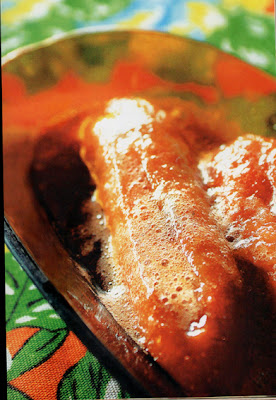 In Fortaleza, my Brazilian hometown, now's a good time to dine on the best cuts of beef - filé-mignon, tenderloin, sirloins. (See the previous post on Flavors of Brazil for an explanation why). Consequently, my eye has recently been turning to Brazilian recipes for this lean, tender and flavorful morsel of beef. The following recipe, from Brazilian food-and-wine magazine, Prazeres da Mesa, grabbed my attention for two reasons - first, because its simplicity ensures that the taste of the beef isn't lost in heavy-handed or overly-rich sauces, and second, because the recipe was developed by Chef Cézar Cassiano, of Grupo Noah in São Paulo, not for a restaurant but rather to be served in a hospital. From my limited experience of hospital food, I've never seen a dish like this on the food cart! But if I'm ever in hospital, let's hope it's in Hospital São Luiz in São Paulo, and let's hope this dish is on the menu.
In Fortaleza, my Brazilian hometown, now's a good time to dine on the best cuts of beef - filé-mignon, tenderloin, sirloins. (See the previous post on Flavors of Brazil for an explanation why). Consequently, my eye has recently been turning to Brazilian recipes for this lean, tender and flavorful morsel of beef. The following recipe, from Brazilian food-and-wine magazine, Prazeres da Mesa, grabbed my attention for two reasons - first, because its simplicity ensures that the taste of the beef isn't lost in heavy-handed or overly-rich sauces, and second, because the recipe was developed by Chef Cézar Cassiano, of Grupo Noah in São Paulo, not for a restaurant but rather to be served in a hospital. From my limited experience of hospital food, I've never seen a dish like this on the food cart! But if I'm ever in hospital, let's hope it's in Hospital São Luiz in São Paulo, and let's hope this dish is on the menu.___________________________________________________
RECIPE - Grilled Filé-mignon with Herbs (Filé-mignon Grelhado com Ervas)
serves 4
4 individual filés-mignon, about 1/2 lb (250 gr) each
salt to taste
8 Tbsp extra-virgin olive oil
3 Tbsp light soy sauce
1 Tbsp finely chopped parsley
1 Tbsp fresh sage
1 Tbsp fresh basil, torn into smaller pieces if the leaves are large
2 Tbsp extra-virgin olive oil
1 Tbsp fresh rosemary
1 Tbsp rice vinegar
10 cloves garlic
----------------------------------------------------------------------------
Peel the garlic cloves, and lightly smash them with the side of a knife or cleaver, making sure they stay whole. Season the steaks with salt. Reserve.
Heat a deep, heavy frying pan over medium-high heat. Add 6 Tbsp olive oil and heat until hot but not smoking. Add the steaks and fry for about 4 minutes per side, depending on desired degree of doneness. When done, remove the steaks from pan and reserve, keeping warm.
Add the remaining two Tbsp oil to the same pan. Turn the heat to medium, then add the garlic and rosemary. Cook until the garlic is just browned, but not burnt. Remove the pan from the heat - then remove the garlic, reserving the pan with flavored oil.
In another small frying pan, heat 2 Tbsp olive oil over high heat. When hot but not smoking, add the fresh parsley, sage and basil and fry briefly - until the herbs are crispy. Remove the herbs, and drain them on a paper towel to absorb excess oil.
Return the larger frying pan to the heat. When hot, add the reserved steaks, plus the vinegar and soy sauce. Heat, turning the steaks over once, for a short time, until the meat is hot and the sauce has thickened a bit.
Place one steak on each of four plates, and mound some of the crispy fresh herbs on top. Serve immediately.













































